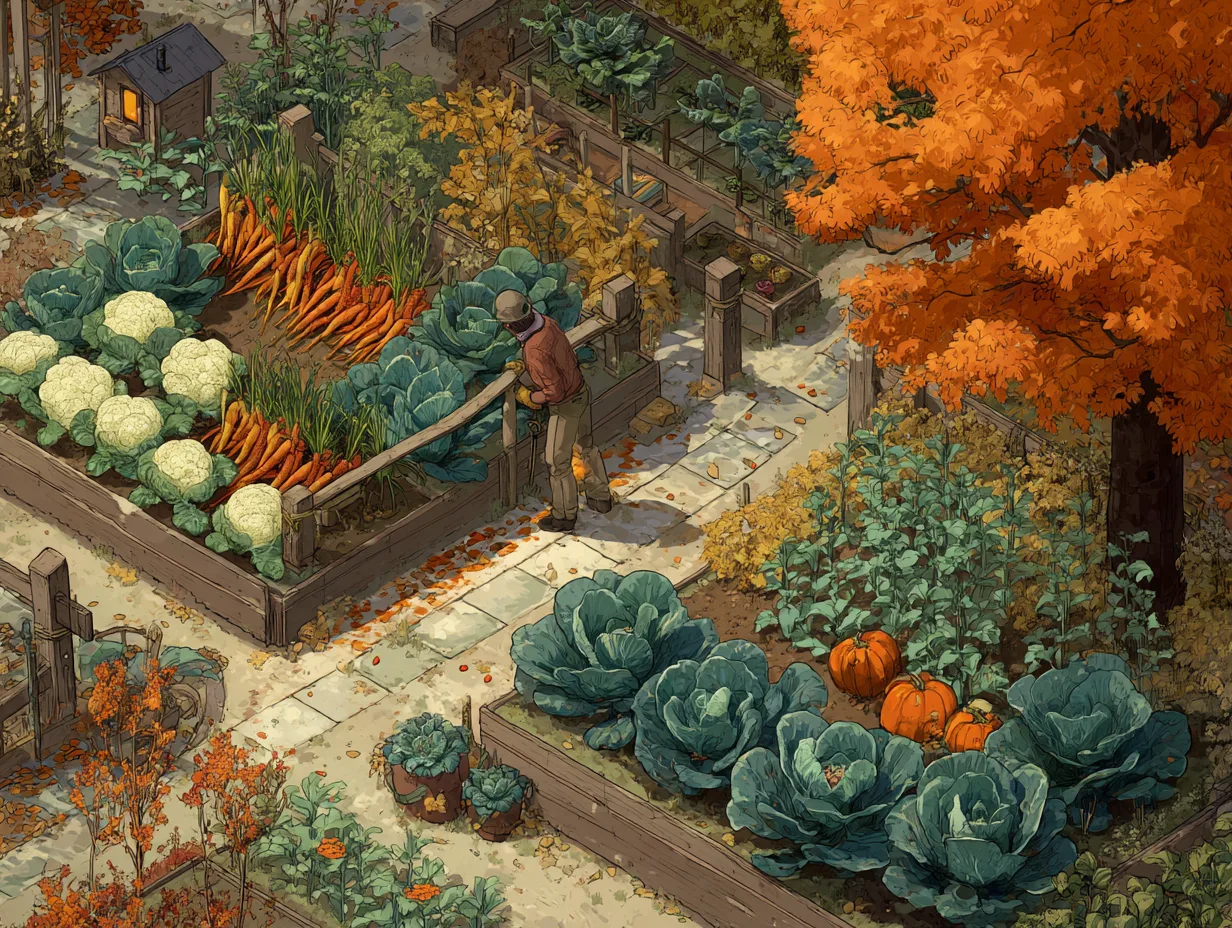Crops That Thrive in Cooler Weather
Autumn is a second spring—a window when crispy mornings and dwindling daylight coax exceptional flavor and color from cold‑tolerant crops. A thoughtful Fall Vegetable Gardening Guide helps you pivot from summer exhaustion to fresh harvests of kale, carrots, and bok choy. This in‑depth article maps out crop choices, sowing schedules, micro‑climate hacks, and season‑extension tricks, weaving in insights from The Year-Round Vegetable Garden for Beginners plus research‑backed tips from land‑grant universities. Use it to transform fading tomato beds into vibrant fall salad bars, root cellars, and pantry staples—no greenhouse required.
1 Why Plant a Fall Garden?
- Enhanced Flavor: Cool nights trigger sugar accumulation in brassicas and roots.
- Fewer Pests: Heat‑loving insects decline, reducing pressure on greens.
- Efficient Space Use: Replant spent summer beds for a bonus harvest.
- Winter Pantry: Late plantings of garlic, onions, and overwintering spinach set you up for spring.
Need proof of tastier cold crops? Check University of Wisconsin data on post‑frost Brix increases in kale.
2 Frost Dates and Back‑Timing
Know your first expected frost. Count back days‑to‑maturity (DTM) plus a two‑week buffer to set your last sowing date. Plug ZIP codes into the NOAA Climate Toolkit (external). Example for Zone 6 (first frost ≈ 10 October):
| Crop | DTM | Buffer | Last Planting |
|---|---|---|---|
| Spinach | 40 | 14 | 17 Aug |
| Broccoli (transplant) | 60 | 14 | 18 Jul |
| Carrots | 70 | 0* | 1 Aug |
*Carrots sweeten under light frost, so buffer optional.
For customized calendars, revisit How to Create a Garden Calendar.
3 Top Fall Crops and Varieties
3.1 Leafy Greens
- Spinach: ‘Giant Winter’ resists 20 °F under row cover.
- Mâche (Corn Salad): Sows itself once established—guide in Growing Salad Greens from Bitter to Sweet.
- Kale: ‘Red Russian’ and ‘Winterbor’ gain sweetness after frost.
3.2 Brassica Heads
- Broccoli: ‘Arcadia’ tolerates 25 °F.
- Cauliflower: ‘Snow Crown’ for quick 52‑day heads; stash with Raised Row Gardening spacing.
- Napa Cabbage: ‘Bilko’ bolts less in warm autumns.
3.3 Root Crops
- Carrots: ‘Napoli’ for overwintering under straw.
- Beets: ‘Detroit Dark Red’ thrives in cooling soil.
- Daikon Radish: Bio‑tills compacted summer beds—learn soil benefits in The Science of Soil.
3.4 Alliums & Bulbs
- Garlic: Plant hardneck ‘Music’ 3 weeks before ground freeze.
- Multiplier Onions (Shallots): Set cloves now for June harvest.
4 Soil Rehab After Summer
- Remove Spent Plants: Chop disease‑free residue into 2″ pieces; compost or surface‑mulch.
- Broad‑Fork: Loosen without inversion—supports no‑dig ethos (see No‑Dig Gardening).
- Compost Top‑Dress: 1–2 inches replenishes nutrients lost to heavy summer feeders.
- Re‑Mulch Paths: Fresh straw suppresses late‑season weeds.
5 Seed Starting and Transplanting Strategies
5.1 Indoor or Shaded Nursery
Late‑July sun fries brassica seedlings. Start trays under 40 % shade cloth or indoors under LEDs, then harden off at dusk for a week.
5.2 Direct Sowing in Heat
- Carrots & Beets: Cover rows with burlap until germination—Cornell trial showed 30 % higher sprout rate.
- Spinach: Pre‑chill seed 7 days at 40 °F to break heat dormancy.
6 Season‑Extension Tactics
| Tool | Temp Boost | Best For |
| Floating Row Cover (1.0 oz) | +4 °F | Insect blocking & light frost |
| Low Tunnel w/ 6 mil plastic | +10 °F | Deep winter greens |
| Hoop House | +15–20 °F | Zone pushing tomatoes into Nov |
DIY diagrams in Growing Under Cover. University of Missouri’s low‑tunnel ROI study offers cost analysis.
7 Watering and Nutrient Management
- Reduced Evaporation: Shorter days mean 50 % less water than July. Use soil‑moisture sensors or the finger test.
- Liquid Fish & Kelp: Bi‑weekly foliar feeds strengthen cold tolerance.
- pH Check: Rain leaches calcium; apply dolomitic lime if pH dips below 6.2.
Details in Organic Fertilizer for Vegetables.
8 Pest & Disease Shift in Fall
| Threat | Peak | Mitigation |
| Cabbage Worm | Aug–Sep | Row cover, BT spray |
| Slugs | Wet Septembers | Beer traps, copper tape |
| Powdery Mildew (squash) | Cooling nights | Remove infected leaves; neem oil |
Expanded tactics in Eco‑Friendly Pest Control.
9 Harvest Windows & Storage Tips
- Greens: Cut outer leaves; protect core for regrowth.
- Roots: Mulch carrots/beets; dig as needed through snow.
- Cabbage: Twist head ¼ turn to sever feeder roots—prevents split if rains resume.
- Garlic: Cure 2 weeks at 60–70 °F with 40 % humidity.
For in‑depth storage guidelines, consult the University of Minnesota Extension’s root‑cellar handbook.
10 Cover Cropping for Winter Soil Armor
Options
- Crimson Clover: Fixes N, winter‑kills in Zone 6.
- Winter Rye: Scavenges nutrients; crimp in spring.
- Tillage Radish: Bio‑drills, reduces compaction.
Sowing timelines in What Is Green Manure?. For nutrient release rates, visit SARE’s Cover Crop chart.
11 Sample 4×8 Bed Fall Conversion
| Early Aug | Mid Sep | Oct Nov |
| Pull zucchini | Plant broccoli transplants | Harvest & mulch |
| Top‑dress compost | Under‑seed crimson clover | Cover tunnel |
12 Common Mistakes & Quick Fixes
- Planting Too Late: Always back‑count DTM. If behind, choose baby‑leaf cultivars.
- Skipping Shade for Seedlings: Use 30–40 % cloth over brassicas.
- Neglecting Nutrients: Summer crops exhaust beds—always compost before replanting.
- Poor Ventilation in Tunnels: Prop sides on warm days to prevent fungal outbreaks.
13 Bringing It All Together
A strategic fall garden rewards you with sweet greens, hearty roots, and soil primed for spring. Follow this Fall Vegetable Gardening Guide to back‑schedule sowings, rehabilitate soil, deploy season‑extenders, and leverage the cooling climate. Keep notes, observe micro‑climates, and adapt; gardening is local and iterative. For deeper dives—low‑cost hoop‑house builds, thermal mass tricks, or overwinter crop trials—turn to The Year-Round Vegetable Garden for Beginners and the research links provided.
Happy late‑season planting—may your frosty mornings be crisp, your cabbages huge, and your soil richer come spring.


Leave a Reply